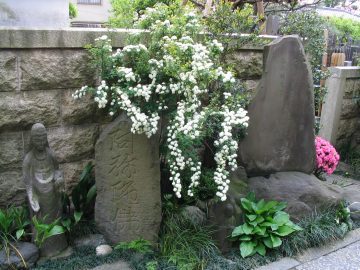
01. Itabi
Taito City Historic Site
Choan-ji, 5 chome 2-22, Yanaka
Itabi also called the stone board stupa or blue stone stupa, is originally a type erected for the repose of the souls of the deceased. Many were made between the Kamakura and Muro-machi Periods. In Choan-ji Temple, there are four Itabi dating back to the Kamakura Period and from the Muro-machi Period.
As Choan-ji Temple is said to have been established in 1669, the Itabi must be about 400 years older than the temple itself. It is said that here was a temple of the Shingon sect before Choan-ji Temple was erected, and therefore, it is considered that the Itabi must have had some connection with the original temple.
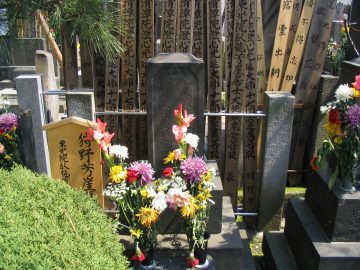
02. Tomb of Kano Hogai
Taito City Historic Site
Choan-ji, 5 chome 2-22, Yanaka
Kano Hogai was a Japanese-style painter in the early Meiji Period. He was born in Chofu City (present Yamaguchi Prefecture) in 1828. At the age of 19 he left for Edo to be apprenticed to Kano Masanobu and mastered painting techniques of Kano school. He was never bound however by the tradition of his school. He was also influenced by Sesshu and Sesson, famous painters of another school and also mastered shading techniques found in western painting. "Hibo Kannon Zu" (goddess merciful like a mother) and "Fudo Myo-o Zu" (god of fire), two of his representative works are designated as Important Cultural Assets.
He contributed much together with Okakura Tenshin to establish the Tokyo Fine Art School (present fine art faculty of the Tokyo University of the Arts) but passed away in November of 1888 at the age of 61 just before the school opened.
His tomb is located near the center of the graveyard of this temple and a stone monument, which was erected in front of the main building in 1917 describes his brief history and achievements.
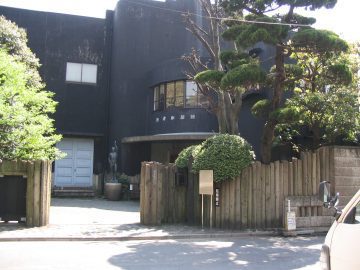
03. Asakura Museum of Sculpture
Place of Scenic Beauty / Registered Tangible Cultural Property
7 chome 18-10, Yanaka
For 56 years from 1907 until his death in 1964, the famous modern sculptor Asakura Fumio kept his residence and studio on this site.
Born in Oita Prefecture in 1883, after graduating from the Tokyo School of Fine Arts (present Tokyo University of the Arts) where he specialized in sculpture, Asakura established his home and studio here. There were repeated additions and refurbishments to the building and the existing structure consists of the older studio built in 1923, as well as the newer workspace and living quarters added in 1935. Numerous works were produced in the original building, including the famous Hakamori (Grave Keeper) Tsurusareta neko (Cat Pinched by the Neck), and Toki no nagare (Flowing Time).
Although the structure is divided between a Japanese style living area based on sukiyazukuri and a studio of modern Western design, one can see the character of Asakura Fumio in details such as the studio floor that can be elevated in order to work on large-scale sculptures. Designed by Asakura himself, the garden employs natural spring water and is called Goten no suitei (The Spring water Garden of Five Precepts). The large stones representing Jin(Benevolence), Gi(Justice), Rei (Propriety), Chi(Wisdom), and Shin(Fidelity) are placed throughout the garden and it has become a relaxing space for visitors.
In carrying out Asakura’s expressed will, the building was opened to the general public in 1967 and came under the management of Taito City in 1986, at which time it was renamed the Taito Municipal Asakura Sculpture Museum.
In 2001 the building was designated a National Registered Cultural Property and the plaster prototype for Hakamori (Grave Keeper) kept inside the building was designated an Important Cultural Asset.
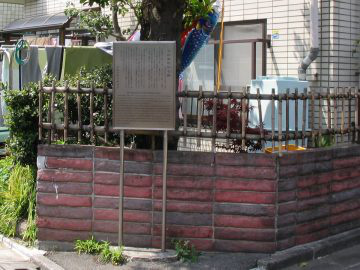
04. The Remains of Koda Rohan's Home
7 chome 18-25, Yanaka
Koda Rohan (1867-1947) is one of the famous literary writers of modern Japan. From January of 1891, he lived on this site for nearly two years. The Sangoju or "Coral Tree" (Caprifoliaceae-Viburnumawabuki) growing on this spot is said to have been here since the time of his home.
From this point, approximately 250 meters to the southeast was the Gojunoto (Five Storied Pagoda) of Ten-no-ji Temple. The Gojunoto was built in 1644 before being destroyed by fire in 1772 and subsequently rebuilt in 1791 by the master carpenter Hatta Seibei. From his home, Rohan spent his days gazing toward Gojunoto and, in November of 1891, he published his masterpiece "Gojunoto (Five Storied Pagoda)" whose main character is based upon Hatta Seibei. A strong-willed hero spare with words; the "ponderous Jubei" is an archetypal image of Japans craftsman.
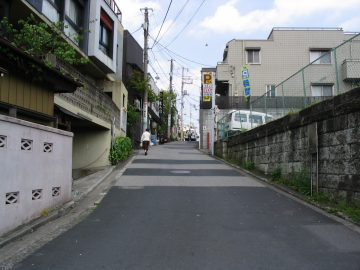
05. Shichimen Slope
5 chome 11, Yanaka
In a book called "Saikō Edo Sunago" written in the mid 19th Century, it is written that the slope leading down from the Sorin-ji Temple to a place called Shichimen, was called the Shichimen Slope. Toward the north of the top of the slope, there is the Enmei-in Temple which has a small shrine called Shichimen-do in its precincts. So, this place was called Shichimen and the slope took its name from the temple.
Records in 1826 show that this slope was about 3.6 meters wide, 90 meters long and 6 meters in height.
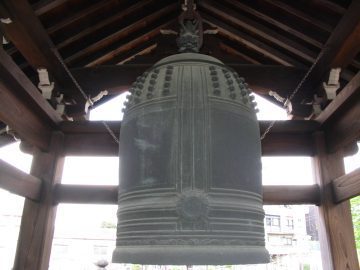
06. Copper Bell
Taito City Tangible Cultural Properties
Chomyo-ji, 5 chome 10-10, Yanaka
This copper bell was donated by Yashiro Yasutsugu for "Gyakusyu Kuyo". A "Gyakusyu Kuyo" is a Buddhist service held by worshipper while the subject is still alive so his soul should rest in peace after death.
The bell, approx 48 inches high and 30 inches in diameter, was created by Shina Yoshihiro, a member of the renowned Shina family. The Shina family was famous smith for their copper works in the latter half of 1600s. Number of pieces produced by them remained to this day. Yoshihiro made a major contribution with his craftsmanship circa 1681-1700. 26 pieces by him exist today, including 19 copper bells, 2 pairs of copper lanterns, a basin, and a pagoda. The pagoda is of special note as it is the tomb of Tokugawa Ietsuna, located at Kan-eiji Temple in Ueno. Ietsuna was the 4th lord of Tokugawa Clan and the Shogun. The fact that Yoshihiro was chosen to build Shogun's tomb tells that he was the copper craftsman with outstanding skill in his time.
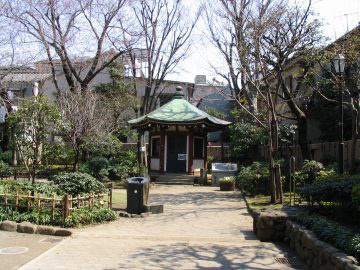
07. The Remains of Okakura Tenshin's Home, Former Zenki Nihon Bijutsuin
Metropolitan Historic Site
Taito City Okakura Tenshin memorial park, 5 chome 7, Yanaka
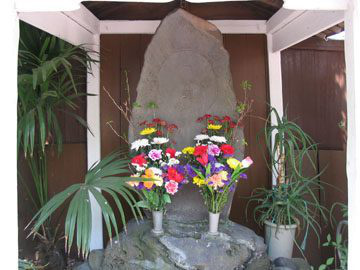
08. The History of Mishima Jizo-son
Taito City Hatsune children park, 3 chome 7-1, Yanaka
During the Pacific War at 8:40 am on March 4th, 1945, the Yanaka area suffered an air raid by B29 bombers. Approximately 500 people were killed or injured and about 200 houses were partially or wholly destroyed.
In 1948, when the war was over people living in the three districts of Sansaki-Cho, Hatsune-Cho 4-chome and Mashima-Cho had a statue of the Buddhist guardian deity Jizo erected to be a permanent memorial to the spirits of the 70 or more people who had died as a result of the war.
The name “Mishima” was derived by taking one character from the name of each of the three districts and adopting alternative readings for two of the characters so that they could be pronounced easily when put together.
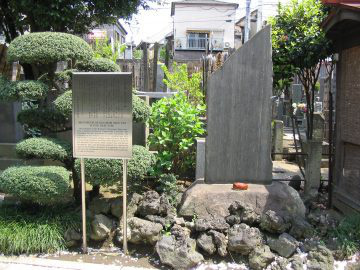
09. Monuments of Kasamori Osen and Suzuki Harunobu
Dai-enji Temple, 3 chome 1-2, Yanaka
The inscription on the Monument of Kasamori Osen represents a sentence written by Nagai Kafu, a novelist. The inscription for the monument of Suzuki Harunobu, the originator of the Nishikie color print, standing next to it was written by Sasagawa Rinpu, a man of letters. Osen was a tea-serving woman at tea house called Kagiya in front of the Kasamori Inari Shrine. Osen's beauty was well-known throughout Edo, and Harunobu depicted her fascinating figure in his Nishikie color print. It is supposedly because of this that the monuments of Osen and Harunobu stand side by side at this place.
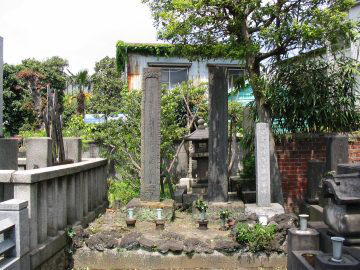
10. Tomb of Ito Genboku
Metropolitan Historic Site
Tenryu-in Temple, 4 chome 4-33, Yanaka
Ito Genboku was a physician of Dutch medicine at the end of the Edo Period. He was born into an agricultural family from what is now Saga Prefecture in 1800. Wishing to become a doctor, he translated from the Dutch language and studied Western medicine under the German physician Philipp Franz von Siebold in Nagasaki.
He began his practice in Edo (present-day Tokyo) in 1828 and, in 1831, became an official physician of the Saga Domain. From 1833, he began to receive many students and visitors at his residence-cum-school known as the Shosen-do located on Shitaya Izumibashi Street.
The central focus of his endeavors came to be the foundation of the first inoculation center in Edo. Built in 1858 in Kanda Otamagaike, it was relocated the following year in Ito's neighborhood on Shitaya Izumibashi Street. In 1860, the Bakufu government took over direct control of the center, renamed it the Seiyo Igaku sho (Institute of Western Medicine), and appointed Genboku in charge of its management. After the transition from Tokugawa rule to the Meiji State in 1868, the institute served as the predecessor of what is now the University of Tokyo School of Medical Science. In 1871 Ito Genboku died at the age of 72 and was buried here at Tenryu-in Temple.
Further information can be found in the posted explanation at Ito's home and inoculation center located at Taito 1-30.
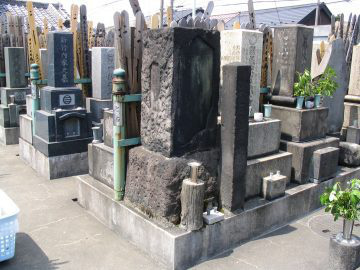
11. The Grave of Kanagaki Robun
Eikyuji, 4 chome 2-37, Yanaka
Kanagaki Robun was a fiction writer and journalist at the end of the Edo Period and beginning of the Meiji Period. His real name was Nozaki Bunzo and he was born in Kyobashi in Edo (old Tokyo) in 1829. He was apprenticed to a merchant but aspired to fiction writing and eventually started a novelist's lifestyle, reading cheap literature and travelling around.
In 1860 he wrote his humorous work "Kokkei Fujimode" which established his name and in the Meiji Period he published works such as "Seiyo Dochu Hizakurige" and "Agura Nabe" which satirized the "civilization and enlightenment" occurring in Japan at the time.
These works made him a popular novelist of the period. Later, moving into the world of journalism he was active writing witty prose for various newspapers.
He died in 1894 at the age of 66 and his grave is in this temple.
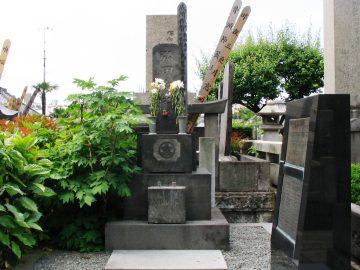
12. The Tomb of Hirota Ryutaro and the Monument to His Music
Zensho-an, 5 chome 4-7, Yanaka
Born in 1892 in Kochi Prefecture, Hirota Ryutaro is known for several famous compositions, including Haru yo koi (Waiting for Spring) and Shikararete (After Being Scolded). Graduating from the Tokyo School of Music (present Tokyo University of the Arts) in 1914, he was also a researcher and educator. Going to Germany for further scholarship in 1928, he returned to Japan in July of the following year to take an appointment as professor at his alma mater. However, he decided to retire from this position in September of the same year in order to devote himself to musical composition.
Hirota Ryutaro has had a tremendous influence in the world of music with both his compositions and choral arrangements. He was very active and has been credited with over a thousand songs. His major works include; Kutsu ga naru (Shoes Squeak), Suzume no gakko (Sparrows' School), Ame (Rain), Koinobori, Oyama no osaru (Mountain Monkey), Hama-chidori (Plover), Komoro naru kojo no hotori (Strolling Around an Old Castle), and Chikumagawa ryojo no uta. His music is still greatly cherished.
He died in 1952 and was buried here at Zensho-an Temple. The memorial that sits beside the grave he shares with his wife was erected by his relatives in 1989 and displays the music and lyrics of Shikararete (After Being Scolded).
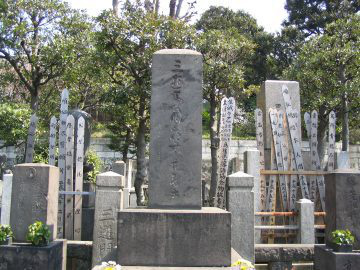
13. The Grave of Sanyu-tei Encho
Metropolitan Historic Site
Zensho-an, 5 chome 4-7, Yanaka
Sanyu-tei Encho (1839-1900) is a rakugoka (a comic storyteller), and also had a popular name Izubuchi Jirokichi. He was born as the first son of Tachibanaya Entaro, a musician, at Yushima. He was apprenticed to the second San-yutei Encho, and became Shin-uchi, the main performer, at 16 in 1855. He was good at telling ghost stories such as Botandoro. Zensho-an Temple keeps a number of drawings of ghosts which were collected by Encho.
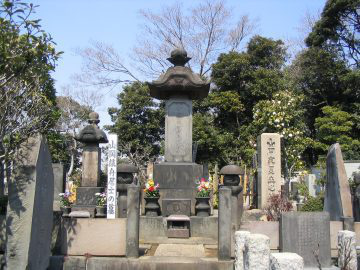
14. The Grave of Yamaoka Tetsusyu
Metropolitan Historic Site
Zensho-an , 5 chome 4-7, Yanaka
Yamaoka Tesshu (1836-1888) is a swordsman as well as politician between the end of the Edo Period and beginning of the Meiji Period. He learned swordsmanship of Ittoryu style from Inoue Kiyotora while his father worked in Hida (Present Gifu Prefecture). Later he came back to Edo and took over Yamaoka Family who was a warrior. He made a great effort as a guard for Tokugawa Yoshinobu, moreover as a negotiator for the Edo Castle Muketsukaijo (the bloodless surrender of Edo Castle) supported with Katsu Kaishu. Yamaoka Tesshu joined Meiji Government and assigned to a general affairs of the Imperial Household. He was also established Mutoryu (school of swordsmanship) in 1880.
He died in 1887 and was buried in Zensho-an Temple which was founded by himself.

















